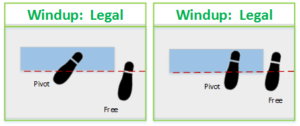Rule Clarification: The pitcher may not take a second step toward home plate with either foot, or otherwise move his pivot foot during their delivery. With no runners on base, this shall be an illegal pitch pursuant to rule 6.02(b). With a runner or runners on base, this shall be a balk pursuant to rule 6.02(a).
A pitcher is not permitted to jump or push forward off the pitcher’s plate with his pivot foot and then bring this foot to the ground and make a second push off prior to delivering the pitch. This delivery should be considered an “illegal pitch” and with runners on base shall be called a “balk”. With no runners on base it shall be called a “ball”. A pitcher should not be considered to be in violation if he pushes off the pitcher’s plate with his pivot foot and maintains consistent contact with the ground with his pivot foot without a second push off from the ground.
Rule Clarification: With a runner or runners on base, a pitcher shall be presumed to be pitching from the set position if he has his pivot foot parallel to and in contact with the pitcher’s plate and his other foot in front of the pitcher’s plate and must therefore fulfill the obligations of pitching from the set position prior to delivering a pitch unless, prior to the start of an at-bat, the pitcher notifies the umpire that he is pitching from the windup position. Upon receiving such notification from the pitcher, the umpire shall then inform the offensive team that the pitcher has declared he will be pitching from the wind-up position. In the event a pitcher assumes the rubber consistent with the set position, fails to declare to the umpire he is using the windup, and delivers a pitch from the windup, the pitcher shall be charged with a balk.
Below is a video of a bullpen session featuring David Price. As the video shows, Price initially begins pitching from a legal set position, throwing three pitches as if he is holding a runner on base. As the video progresses however, you will notice that Price, from a starting position consistent with the set position, pitches from a wind-up motion, beginning at approximately 1:05. As you can see from the video, it is impossible to discern whether Price is in the wind-up or set position from his foot position, giving him an advantage with regard to holding a runner on base. The image below identifies the difference between foot position for the wind-up and set positions (from the perspective of a right-handed pitcher).
Any time, with runners on base, if a pitcher assumes a position on the mound consistent with the set position, he must meet the requirements of a legal delivery from the set position (engage the rubber with hands apart, bring them together for a discernible pause, and then deliver to the batter), unless he declares to the plate umpire that he wishes to use a wind-up motion. Once the pitcher declares he will be using the wind-up, he must remain in the wind-up for the duration of the at-bat, unless the hitter is substituted for, there is a change in the position of the runner(s) on base, or the side is retired. In the event that the pitcher does not declare for any reason, he shall be charged with a balk.
Please note that if you observe a pitcher whose wind-up could potentially be in violation of this rule, the first time a situation arises where they may elect to use the wind-up (R3 only, R2/R3, or bases loaded), it is completely acceptable for an umpire to ask the pitcher, on his own accord, if the pitcher intends to use the wind-up.


